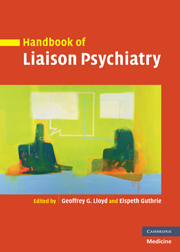Book contents
- Frontmatter
- Contents
- List of contributors
- Preface
- Part I Basic skills
- Part II Common psychiatric problems across the general hospital
- Part III Working with specific units
- 14 Neurological disorders
- 15 Cardiorespiratory disorders
- 16 Gastrointestinal disorders
- 17 Liver disorders
- 18 Endocrine disorders
- 19 Diabetes
- 20 HIV and AIDS
- 21 Renal disease
- 22 Musculo-skeletal disorders
- 23 Oncology
- 24 Head and neck cancer
- 25 Palliative care
- 26 Cosmetic procedures
- 27 Perinatal and gynaecological disorders
- 28 The intensive care unit
- 29 The burns unit
- 30 Psychocutaneous disorders
- 31 Genitourinary disorders
- 32 The emergency department
- Part IV Treatment
- Part V Different treatment settings
- Index
- References
20 - HIV and AIDS
from Part III - Working with specific units
Published online by Cambridge University Press: 10 December 2009
- Frontmatter
- Contents
- List of contributors
- Preface
- Part I Basic skills
- Part II Common psychiatric problems across the general hospital
- Part III Working with specific units
- 14 Neurological disorders
- 15 Cardiorespiratory disorders
- 16 Gastrointestinal disorders
- 17 Liver disorders
- 18 Endocrine disorders
- 19 Diabetes
- 20 HIV and AIDS
- 21 Renal disease
- 22 Musculo-skeletal disorders
- 23 Oncology
- 24 Head and neck cancer
- 25 Palliative care
- 26 Cosmetic procedures
- 27 Perinatal and gynaecological disorders
- 28 The intensive care unit
- 29 The burns unit
- 30 Psychocutaneous disorders
- 31 Genitourinary disorders
- 32 The emergency department
- Part IV Treatment
- Part V Different treatment settings
- Index
- References
Summary
Introductory topics
Introduction
The psychiatric care of individuals infected with HIV encompasses a wide range of issues which, as for other chronic and life-threatening illnesses, include biological, social and psychological factors (Table 20.1). Due to the diversity of these issues, deliverance of mental health care for those with HIV infection or disease is best carried out in a multidisciplinary team setting involving co-ordination and co-operation between HIV physicians, social services, community mental health teams, child and adolescent mental health services and voluntary sector organizations as appropriate. HIV liaison psychiatry attempts to integrate the medical, psychological and social aspects of HIV and can make a unique contribution to the care and management of affected individuals (Clark & Everall 1997). In this chapter, the main aspects of HIV in the adult population and its effects on mental state are considered in terms of epidemiology, clinical manifestations and management. In addition, the impact of HIV on the mental health of two special populations – children and older adults – is considered briefly.
Epidemiology of psychiatric morbidity in those infected with HIV
Routes of transmission of HIV include sexual transmission, transmission in blood/blood products, and vertical transmission, from mother to child. In the UK the groups with the highest prevalence are homosexual men, sub-Saharan African populations (primarily due to heterosexual transmission), and intravenous drug users. Recent figures suggest that the prevalence of HIV infection in the UK is 0.11% as compared to 0.35% in Western Europe (WHO fact sheet 2000).
Keywords
- Type
- Chapter
- Information
- Handbook of Liaison Psychiatry , pp. 474 - 505Publisher: Cambridge University PressPrint publication year: 2007



